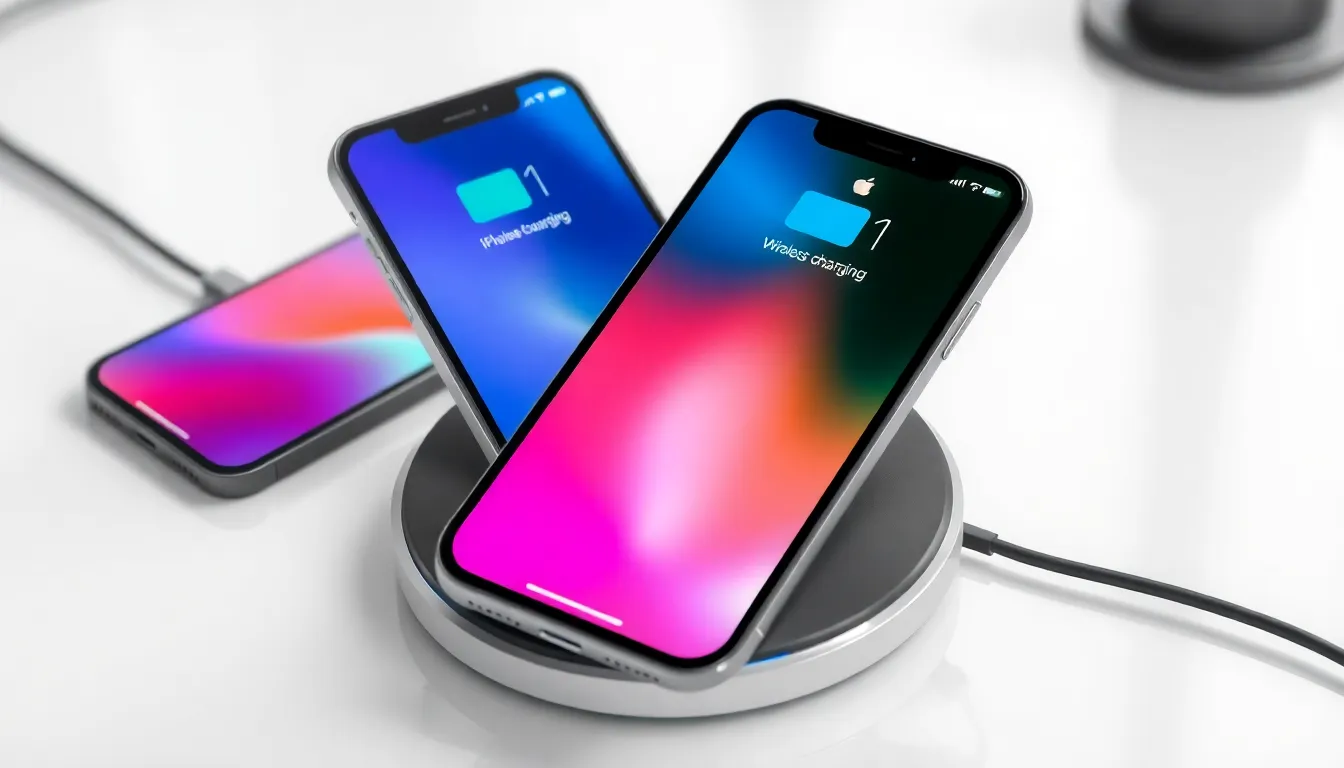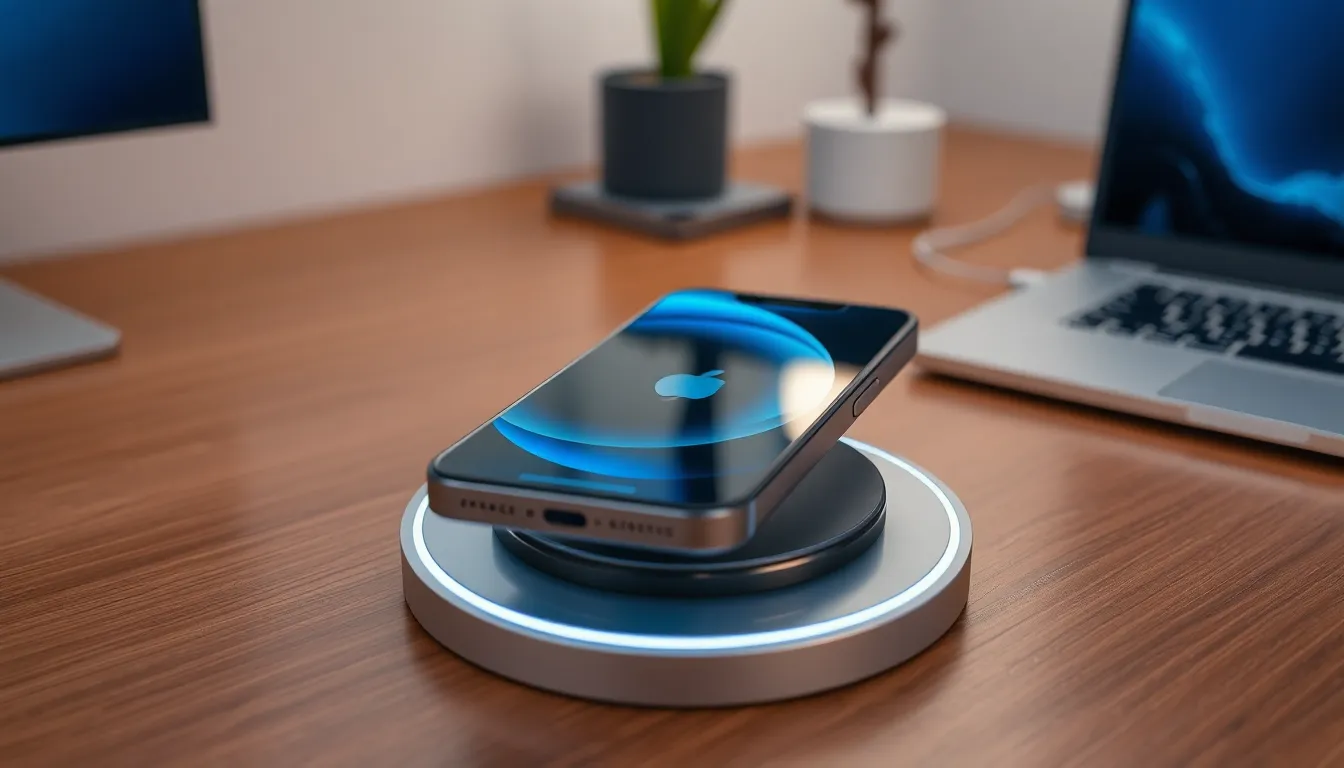Imagine a world where charging your iPhone doesn’t involve wrestling with tangled cords or searching for an outlet. Since its debut, wireless charging has transformed the way users power up their devices, making life just a little bit easier. But when did this magical convenience first grace the iPhone?
The journey began in 2017 with the iPhone 8 and iPhone X, introducing the world to the joy of simply placing their phones on a charging pad. No more fumbling with plugs or worrying about frayed cables. As Apple embraced this technology, it opened the door to a future where charging is as effortless as a gentle nudge. Dive into the fascinating history of wireless charging on iPhones and discover how this innovation changed the game for tech enthusiasts everywhere.
Table of Contents
ToggleOverview of Wireless Charging
Wireless charging technology for the iPhone debuted in 2017 with the launch of the iPhone 8 and iPhone X. This innovation marked a significant shift in charging methods, allowing users to simply place their devices on a charging pad. The transition to more convenient charging eliminated the problem of tangled cords.
Qi technology serves as the standard for wireless charging, ensuring compatibility across various devices. This standardization brings ease, as multiple brands and vendors support Qi-enabled chargers. Users benefit from this as they can use the same charger for different devices.
With wireless charging, users experience advantages such as faster charging times. The iPhone utilizes inductive charging methods, which enhance charging efficiency compared to traditional wired charging. Moreover, convenience plays a key role. Charging stations are widely available in public areas like cafes and airports, enabling easy access when on the go.
Adoption of wireless charging is evident. Reports indicate that many iPhone users appreciate the ease of charging without dealing with plugs and cords. As technology continues to develop, innovations in wireless charging continue to emerge, promising improvements in speed and efficiency. This evolution in charging methods highlights how the tech industry prioritizes user convenience.
History of Wireless Charging Technology

Wireless charging technology has a rich history, with significant advancements leading up to its adoption in smartphones. It enables users to power their devices without cords, significantly enhancing convenience.
Early Developments
Inductive charging emerged in the late 19th century, primarily driven by Nikola Tesla’s experiments with wireless energy transfer. Research continued through the 20th century, leading to prototypes designed for small electronics. In 2009, the Wireless Power Consortium introduced the Qi standard, creating a unified platform for wireless charging. By 2012, several manufacturers offered Qi-enabled devices, paving the way for broader adoption in consumer electronics.
Key Innovations
Advancements in wireless charging technology included improvements in efficiency and speed. The introduction of resonant inductive coupling allowed devices to charge at greater distances. In 2017, Apple incorporated Qi wireless charging into the iPhone 8 and iPhone X, marking a major milestone in smartphone technology. Dual charging pads also became popular, enabling users to charge multiple devices simultaneously. This wave of innovation shaped charging habits, reinforcing the preference for wireless solutions in modern tech.
Wireless Charging for iPhone
Wireless charging emerged for iPhones in 2017 with the launch of the iPhone 8 and iPhone X. This technology made charging effortless; users simply placed their devices on compatible charging pads.
When Did Wireless Charging Start on iPhone?
The introduction of wireless charging marked a significant change in how users powered their devices. It aligned with the growing trend for convenience in technology. The arrival of the iPhone 8 and iPhone X showcased this advancement, making it clear that Apple embraced this innovation fully.
iPhone Models with Wireless Charging
Several iPhone models now support wireless charging. Starting with the iPhone 8, iPhone X, and subsequent iPhones like the iPhone 11, iPhone 12, and iPhone 13, each model continued this feature. Recent models, including the iPhone 14, further refined the technology, enhancing charging speeds and compatibility. This feature evolves with every generation, reflecting user demand for ease and efficiency in charging practices.
Benefits of Wireless Charging
Wireless charging offers several key advantages that enhance user experience. Convenience stands at the forefront, allowing users to simply place their iPhones on a charging pad without dealing with cables. This method eliminates the frustration of tangled cords, providing a cleaner charging solution.
Efficiency also plays a crucial role in wireless charging. Inductive charging methods facilitate faster charging times compared to traditional wired options. Users notice significant improvements in charging speeds, making this technology a practical choice for busy individuals.
Compatibility represents another notable benefit. Qi technology ensures that various devices can utilize the same wireless charger. This universal standard means users can charge multiple products without needing different chargers, reducing clutter.
Public accessibility adds to the appeal of wireless charging. Many businesses, airports, and cafes now offer wireless charging stations for customers. This widespread availability enhances convenience for users on the go, making it easier to power up their devices anywhere.
Furthermore, advancements in wireless charging technology continue to shape user habits. Innovations like dual charging pads allow multiple devices to charge simultaneously. Such features cater to users with various gadgets, emphasizing the demand for efficient charging solutions.
Additionally, as iPhone models have adopted wireless charging, user satisfaction has increased. With each new release, enhancements in charging speed and performance reinforce the growing preference for this technology. Embracing wireless charging aligns with the overall trend of prioritizing convenience in the tech industry, delivering seamless experiences for iPhone users.
Future of Wireless Charging
Future advancements in wireless charging technology aim to enhance user convenience and efficiency. Newer iPhone models, such as the iPhone 14, already showcase improvements in charging speeds and compatibility. Upcoming iterations of the iPhone are likely to continue this trend, integrating even faster wireless charging capabilities.
Research into more efficient designs highlights potential breakthroughs. Innovations in materials and technology may allow for better energy transfer, improving charging times even further. Wireless charging may also expand beyond smartphones, targeting laptops and wearables as the next key devices to adopt this technology.
A shift toward higher power levels is anticipated. Future wireless chargers may support more powerful devices, including laptops and tablets, which could revolutionize the way users interact with energy sources. Increased power output would cater to a wider array of gadgets, enhancing overall convenience.
In the realm of public charging stations, growth is expected. More establishments are likely to incorporate wireless charging pads into their environments. As these stations become ubiquitous in cafes, airports, and public spaces, user reliance on wireless charging will increase.
Moreover, multi-device charging solutions will gain traction. Users with various gadgets will benefit from chargers that can power multiple devices simultaneously. This shift aligns with growing consumer habits centered on efficiency and organization.
Green energy solutions may also play a role. The integration of solar or other renewable resources into wireless charging stations could enhance sustainability. Utilizing clean energy sources would appeal to environmentally conscious consumers, further driving adoption.
Wireless charging has transformed the way iPhone users experience convenience and efficiency. Since its debut in 2017 with the iPhone 8 and iPhone X, this technology has continuously evolved, making charging simpler and more accessible. The integration of Qi technology ensures compatibility across various devices, allowing users to enjoy a seamless charging experience.
As newer iPhone models embrace advancements in wireless charging, the trend shows no signs of slowing down. Future developments promise even faster charging capabilities and broader applications beyond smartphones. With the increasing availability of charging stations in public spaces, wireless charging is set to become an integral part of daily life, reflecting the tech industry’s commitment to enhancing user experiences.




